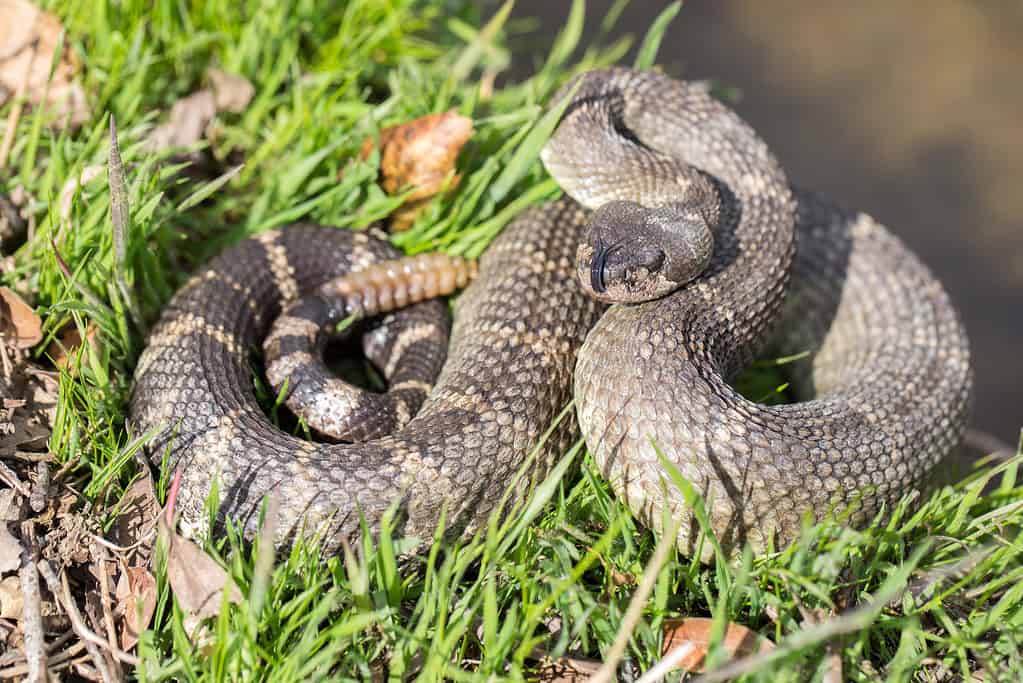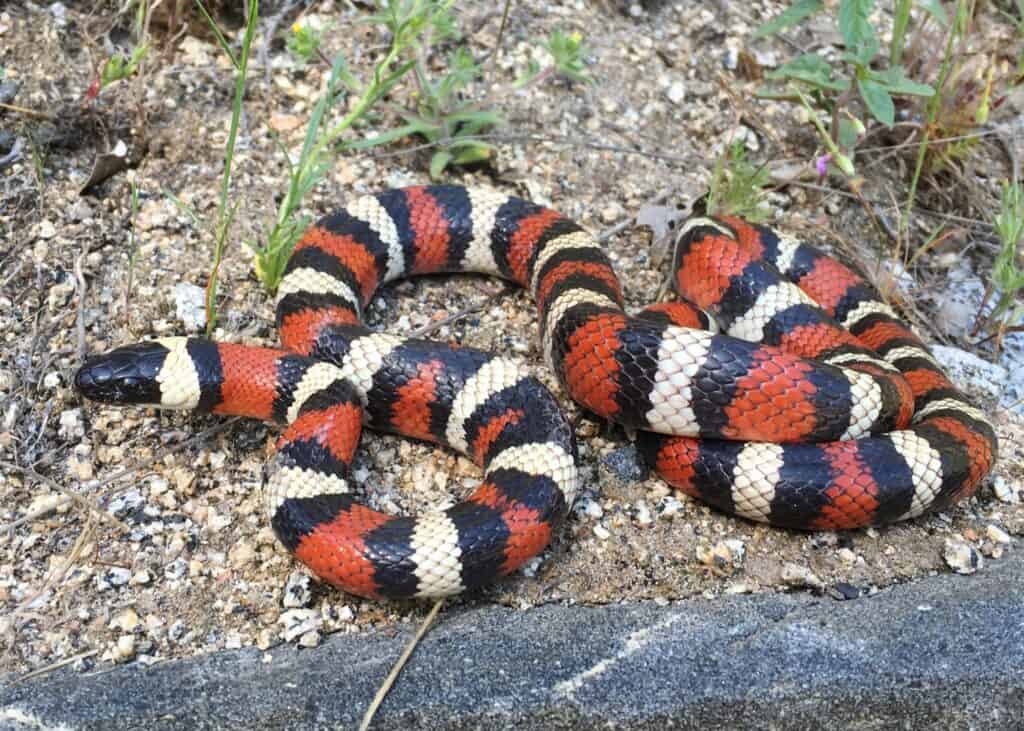Yosemite National Park is a large national park in central California. Located in the Sierra Nevada Mountain range, Yosemite National Park is one of the most well-known parks in the world. The park contains amazing geographic features ranging from giant sequoia trees to crystal-clear streams and waterfalls. It also supports an incredible amount of biological diversity, with 90 species of mammal, 262 bird species, and 11 amphibian species found in the park.
Yosemite National Park also contains a wide variety of reptile species. Inside the park, you can find 22 reptile species, including 1 turtle, 1 skink, 7 lizards, and 13 snakes. Moreover, one of the 13 species found in Yosemite is venomous. But which one? Keep reading if you want to discover the one venomous snake found in Yosemite National Park. We’ll also discuss some common snakes found in the park as well as its most colorful serpent. Finally, we’ll examine when snakes become most active and what to do if you get bitten by a venomous snake.

Yosemite National Park is one of the most well-known parks in the world.
©iStock.com/agaliza
Snakes in Yosemite
Most of the snakes in Yosemite National Park live in the mixed coniferous forests along the state’s western boundary. This area’s mild climate and variety of plant and animal species provide the park’s snakes with the food and shelter they need to survive. In total, 13 snakes make their home in the park. Represented species range from common garter snakes to boas to venomous rattlesnakes. Here is a list of all 13 snake species you can find in Yosemite National Park:
- Northern Rubber Boa – Charina bottae
- Western Yellow-bellied Racer – Coluber coluber Mormon
- Common Sharp-tailed Snake – Contia tenuis
- Ringneck Snake – Diadophis punctatus
- California Nightsnake – Hypsiglena torquata
- California Kingsnake – Lampropeltis californiae
- Sierra Mountain Kingsnake – Lampropeltis zonata
- California Striped Racer – Masticophis lateralis
- Pacific Gopher Snake – Pituophis catenifer catenifer
- Sierra Garter Snake – Thamnophis couchii
- Mountain Garter Snake – Thamnophis elegans
- Valley Garter Snake – Thamnophis sirtalis fitchi
- California Whiptail – Aspidoscelis tigris
- Northern Pacific Rattlesnake – Crotalus oreganus
Venomous Snakes in Yosemite: Northern Pacific Rattlesnake
The northern Pacific rattlesnake ranks as the only venomous snake found in Yosemite National Park. It is distributed throughout western North America and typically lives in rocky areas, desert scrub, grasslands, and coniferous forests.
Most northern Pacific rattlesnakes appear dark gray but can range from light brown to almost black in color. They feature a characteristic pattern of dark brown, gray, or olive blotches along their back. Meanwhile, the belly looks pale yellow and often sports brown spots. Adults vary greatly in size, ranging from 39 inches to nearly 64 inches long.
Northern Pacific rattlesnakes use heating sense pits on their faces to find prey. They mainly feed on rodents, rabbits, and lizards, but will also occasionally eat small birds and amphibians. It uses its venom to immobilize its prey, then swallows it whole.
The northern Pacific Rattlesnake is a relatively docile species. It will usually try to avoid confrontation and will only use its rattle as a warning when threatened. If it feels trapped or threatened, it may coil up and lash out but will typically not follow up with a bite. That said, like all rattlesnakes, northern Pacific rattlesnakes possess potent venom. Common bite symptoms include pain, blistering, and swelling, as well as nausea and vomiting. Their venom can also damage red blood cells and cause major organ damage or failure if left untreated.

The northern Pacific rattlesnake ranks as the only venomous snake found in Yosemite National Park.
©iStock.com/yhelfman
Most Common Snakes in Yosemite: Garter Snakes
Garter snakes are the most common snakes found in Yosemite National Park. Scientists recognize around 35 distinct garter snake species. In Yosemite National Park, you can find three of those species: the Sierra garter snake, the mountain garter snake, and the valley garter snake.
You can find garter snakes throughout much of North America and in a wide variety of habitats. While they often live near water, you can find them in forests, grasslands, woodlands, and fields. Their ability to adapt to most environments is the main reason why these snakes are so common.
Garter snakes vary wildly in appearance depending on the species. That said, they typically feature large, round eyes, narrow bodies, and longitudinal stripes down their backs. They can measure as little as 18 inches long to up to 51 inches long.
Like all snakes, garter snakes are carnivores. Their list of prey includes insects, worms, rodents, small fish, frogs, and lizards. Contrary to popular belief, garter snakes do possess neurotoxic venom. However, their venom poses no threat to humans because of the limited amount of venom they produce.

Garter snakes are the most common snakes found in Yosemite National Park.
©Jason Mints/Shutterstock.com
Most Colorful Snakes in Yosemite: Sierra Mountain Kingsnake
The Sierra mountain kingsnake also goes by the name the California mountain kingsnake. It ranges throughout California, although you can also find it in Oregon and Washington state. Sierra mountain kingsnakes mostly live in and around mountains, hence their name.
In terms of appearance, Sierra mountain kingsnakes closely resemble coral snakes. They sport alternating red, black, and yellow bands on their bodies and black faces. However, unlike the coral snake, Sierra mountain kingsnakes pose little threat to humans. Adults vary in size but can reach 40 inches long.
Sierra mountain kingsnakes kill their prey via construction. Their diet consists of birds, eggs, rodents, and other snakes. In fact, they often eat rattlesnakes because they are immune to rattlesnake venom.

Sierra mountain kingsnakes closely resemble coral snakes in coloring, but pose little threat to humans.
©Matt Jeppson/Shutterstock.com
When Are Snakes Most Active in the Park?
During the winter, most snakes go into a form of hibernation known as brumation. While brumating, snakes become less active, and their metabolism slows down significantly. Snakes are most active in Yosemite National Park from March to August during the spring and summer.
Snakes often hide from the sun during the hottest parts of the day. This means you’re unlikely to find any snakes if you go for a walk on a trail during the middle of the day. That said, you may see a snake sunning itself on a rock or ledge early in the morning or late in the afternoon. Many snakes in the park are nocturnal and often only emerge from hiding at night to feed. To avoid disturbing any resting snakes, stay out of overgrown areas and on well-maintained paths.
What to Do if You Encounter a Rattlesnake?
If you encounter a rattlesnake in the park, don’t try to approach it. Instead, give the snake a wide berth and continue on your way. If a rattlesnake bites you, make sure to seek medical attention as soon as possible. Remove any tight jewelry or other clothing that might cause pain due to swelling. You may wash the bite area with water, or you can choose to leave the wound alone. Some professionals recommend leaving the bite alone, as medical teams can sample the venom around the bite wound to quickly identify the appropriate antivenom. Washing away can remove this easily accessible venom, thereby making detection more difficult. Remember, do not try to cut into a snake bite wound with a knife or other sharp object. Also, do not apply ice to the bite wound or try to suck out the venom.
Up Next
- Discover the 4 Venomous Snakes Near Nevada’s Lake Mead
- The 10 Most Snake-Infested Lakes in the United States
- Discover the 4 Poisonous Snakes in Tennessee
The photo featured at the top of this post is © Ryan M. Bolton/Shutterstock.com
Discover the "Monster" Snake 5X Bigger than an Anaconda
Every day A-Z Animals sends out some of the most incredible facts in the world from our free newsletter. Want to discover the 10 most beautiful snakes in the world, a "snake island" where you're never more than 3 feet from danger, or a "monster" snake 5X larger than an anaconda? Then sign up right now and you'll start receiving our daily newsletter absolutely free.
Thank you for reading! Have some feedback for us? Contact the AZ Animals editorial team.






